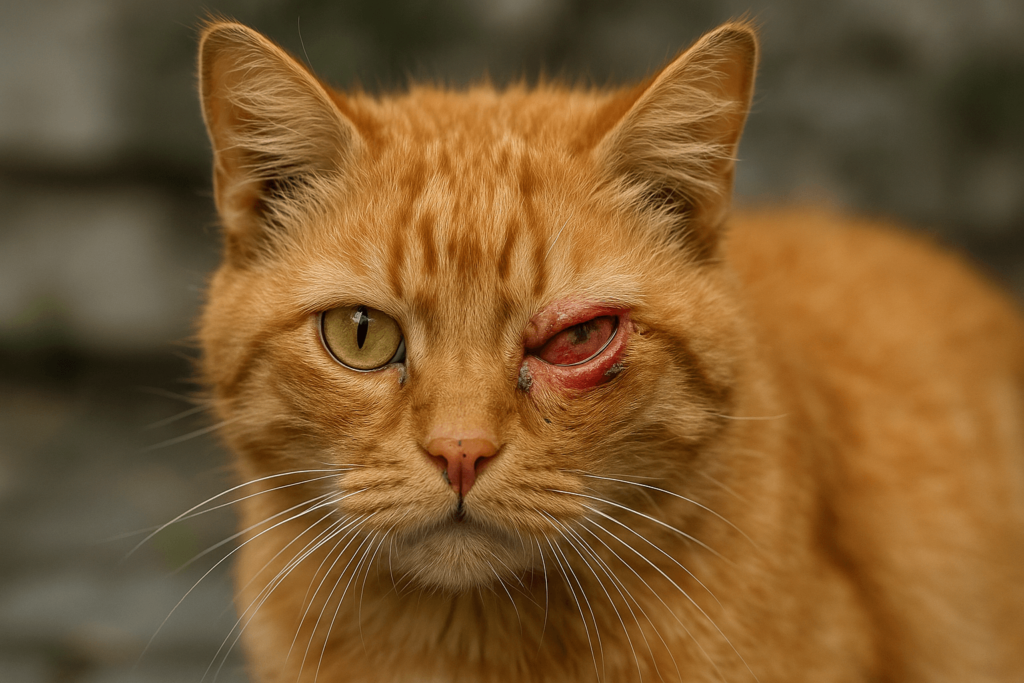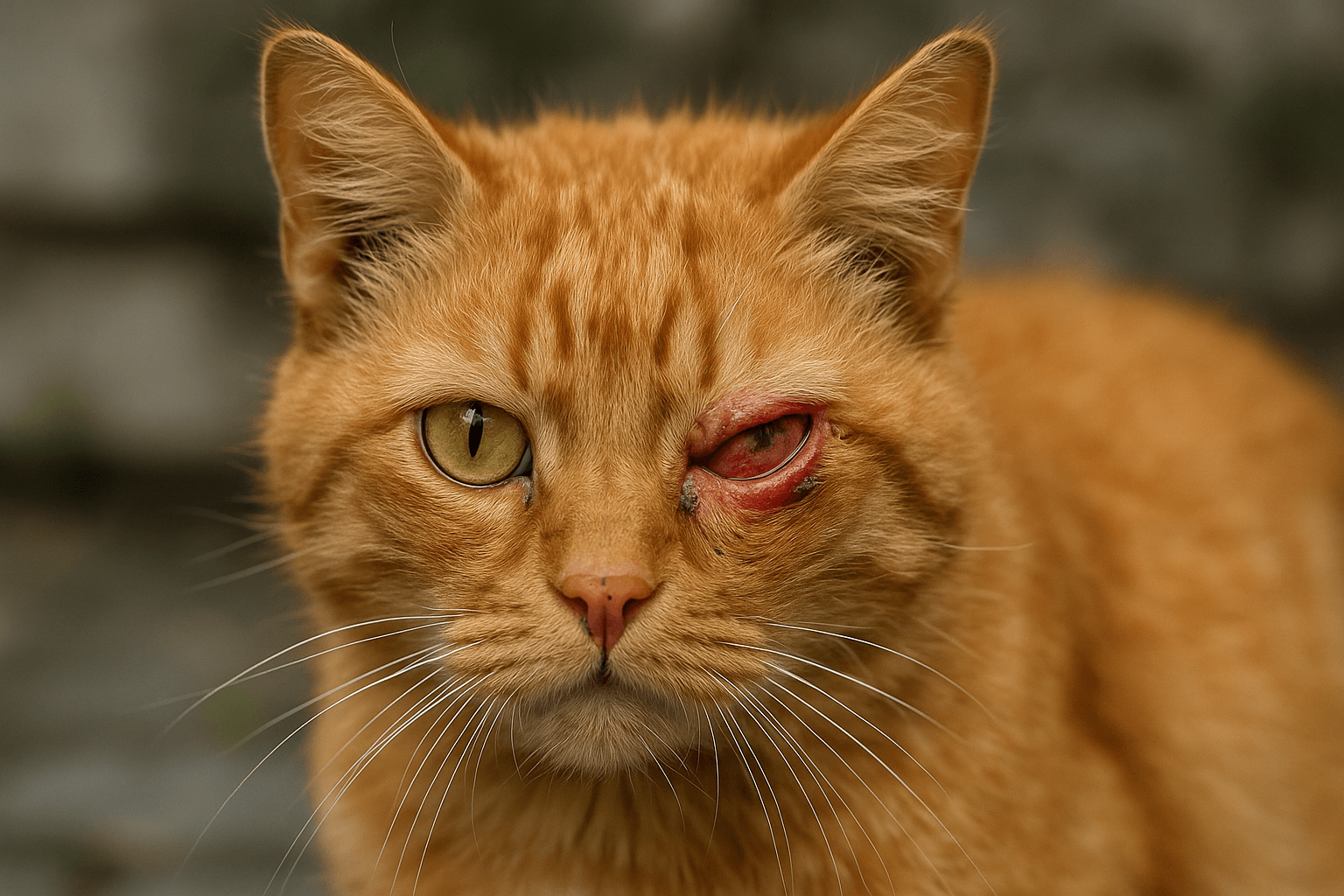Cat Eye Inflammation: Recognizing the Signs and Restoring Your Feline’s Vision
A cat’s eyes are windows to their soul—and when they’re red, watery, or swollen, something’s wrong. Cat eye inflammation isn’t just a cosmetic concern; it’s often the first visible sign of an underlying health issue that demands attention. Whether it’s a minor irritant or a serious infection, ignoring it can lead to pain, vision loss, or even permanent damage. Understanding cat eye inflammation—its causes, symptoms, and solutions—is essential for every cat owner who wants to protect their companion’s sight and well-being.
Why Cat Eye Inflammation Is Never Normal
Eye inflammation in cats is not a standalone condition—it’s a symptom. Your cat’s eyes are delicate, and any disruption signals that their body is reacting to something. Here’s what you need to know:
The eye’s natural defenses are easily overwhelmed.
Even dust, pollen, or a stray eyelash can trigger irritation, but persistent redness means the body can’t resolve it alone.Inflammation is the body’s alarm system.
Swelling, discharge, and squinting are signs your cat’s immune system is actively fighting an invader.Cats hide pain meticulously.
If your cat is blinking more or avoiding light, they’re already in discomfort—don’t wait for them to cry out.Untreated inflammation can lead to ulcers or blindness.
Corneal damage from prolonged irritation is irreversible without prompt veterinary care.It’s often linked to systemic illness.
Conditions like feline herpesvirus or autoimmune diseases frequently manifest first in the eyes.
A red eye isn’t “just a little pink.” It’s a cry for help. Recognizing this early can make all the difference.

Common Causes of Cat Eye Inflammation
Not all eye inflammation is the same. The cause determines the treatment—and knowing the difference helps you act wisely. Here are the most frequent culprits:
Feline Herpesvirus (FHV-1):
The most common viral cause, often flaring during stress. Leads to conjunctivitis, discharge, and corneal ulcers.Bacterial Infections (Chlamydia, Mycoplasma):
Often secondary to viruses. Causes thick, yellow or green discharge and swollen eyelids.Allergies (Environmental or Food):
Pollen, mold, or dietary ingredients can trigger allergic conjunctivitis with watery eyes and itching.Foreign Objects or Trauma:
A blade of grass, dirt, or a scratch from play can lodge in the eye, causing inflammation and pain.Dry Eye (Keratoconjunctivitis Sicca):
Reduced tear production leads to chronic irritation, redness, and sticky mucus buildup.
Each cause requires a different approach. Misdiagnosing one for another can delay healing—or worsen the condition. Always consult your vet for accurate identification.
Check this guide 👉Cat Eye Diseases: Best 7 Expert Tips!
Check this guide 👉Understanding Cat Eye Mites: Best 7 Expert Tips!
Check this guide 👉Understanding Cat Eye Cataracts: Best 7 Expert Tips!
| Symptom | Likely Underlying Cause |
|---|---|
| Red, swollen eyelids with clear discharge | Allergic conjunctivitis or mild viral infection |
| Thick, yellow or green pus-like discharge | Bacterial infection (e.g., Chlamydia) |
| Cloudy cornea or ulcers visible under light | Feline herpesvirus or trauma |
| Frequent squinting or holding eye shut | Pain from foreign object, glaucoma, or ulcer |
| Dry, flaky skin around eyes with mucus buildup | Keratoconjunctivitis sicca (dry eye) |
When to Seek Immediate Veterinary Care
Cat eye inflammation can escalate rapidly. Waiting too long risks permanent damage. These signs mean you need to see a vet today:
Your cat is pawing at their eye or rubbing their face excessively.
This indicates significant pain or discomfort.The eye appears cloudy, bulging, or has a visible white or blue film.
Could signal corneal ulcer, glaucoma, or uveitis—all emergencies.There’s sudden vision loss—bumping into objects, hesitation in dim light.
Vision impairment requires urgent diagnostics.Discharge is bloody or dark brown.
Indicates trauma, severe infection, or internal bleeding.Both eyes are affected simultaneously.
Often points to systemic illness like FIV, FeLV, or autoimmune disease.
Don’t rely on home remedies if these signs appear. Time is vision. Delaying treatment can cost your cat their sight.
How to Care for Your Cat’s Eyes at Home (Safely)
While professional care is essential, gentle home support can aid recovery—only under vet guidance.
Use a damp, warm cloth to gently wipe discharge.
Always use a fresh section of cloth for each eye to prevent cross-contamination.Never use human eye drops or home remedies like tea or honey.
Many contain ingredients toxic to cats or worsen inflammation.Keep the environment clean and dust-free.
Vacuum regularly, avoid scented candles, and close windows during high pollen seasons.Limit stress and maintain routine.
Stress triggers herpesvirus flare-ups. Keep feeding, play, and sleep times consistent.Monitor for changes daily.
Take note of discharge color, swelling level, and behavior. Small changes matter.
Home care supports healing—but it doesn’t replace diagnosis. Use it as a bridge to professional treatment.
Diagnostic Tests Your Veterinarian May Recommend
To treat cat eye inflammation correctly, your vet must identify the root cause. Here’s what to expect during an exam:
Schirmer Tear Test:
Measures tear production to rule out dry eye.Fluorescein Stain Test:
A dye is applied to detect corneal scratches or ulcers under UV light.Swab for Culture and PCR:
Identifies bacterial or viral pathogens like Chlamydia or FHV-1.Intraocular Pressure Test (Tonometry):
Checks for glaucoma, which causes painful pressure buildup.Bloodwork and FeLV/FIV Testing:
Screens for systemic diseases that weaken immunity and affect the eyes.
These tests aren’t optional—they’re necessary. A misdiagnosed infection can become chronic. Accurate testing saves sight.
Treatment Options for Cat Eye Inflammation
Treatment depends entirely on the diagnosis. There’s no one-size-fits-all solution.
Antibiotic Eye Drops or Ointments:
For bacterial infections—often prescribed for 7–14 days, even if symptoms improve.Antiviral Medications (e.g., Famciclovir):
Used for herpesvirus flare-ups to suppress replication and reduce recurrence.Artificial Tears or Cyclosporine:
For dry eye, these replace missing moisture and stimulate tear production.Anti-inflammatory Drops (Steroids or NSAIDs):
Used cautiously under supervision to reduce swelling—never without ruling out ulcers.Surgery (in severe cases):
For corneal perforation, eyelid abnormalities, or glaucoma that doesn’t respond to medication.
Never self-prescribe. Even “mild” inflammation can mask life-threatening conditions. Follow your vet’s protocol exactly.
Preventing Future Episodes of Eye Inflammation
Prevention is far easier—and cheaper—than treatment. Protect your cat’s eyes before problems arise.
Keep vaccinations up to date.
FVRCP vaccine protects against feline herpesvirus and calicivirus, major causes of eye inflammation.Maintain a clean living space.
Dust, smoke, and aerosols irritate sensitive eyes. Use air purifiers and avoid strong cleaners.Trim long hair around the eyes.
Long fur can rub against the cornea, causing chronic irritation—especially in Persians and other flat-faced breeds.Avoid multi-cat stress.
Introduce new pets slowly. Stress triggers herpesvirus reactivation.Schedule annual eye exams.
Especially for older cats or breeds prone to eye issues. Early detection prevents complications.
A little routine care goes a long way toward preserving your cat’s vision—and peace of mind.
FAQ: Cat Eye Inflammation
Can cat eye inflammation clear up on its own?
Sometimes, yes—if it’s mild and caused by a temporary irritant. But if it lasts more than 24–48 hours, or worsens, it’s not “just going away.” See a vet.
Is cat eye inflammation contagious to humans?
Rarely. Bacterial causes like Chlamydia can theoretically infect humans, but transmission is extremely uncommon. Wash hands after handling your cat’s eyes.
Why does my cat’s eye keep getting red after treatment?
Likely a flare-up of feline herpesvirus. This virus stays dormant and reactivates during stress. Long-term management, not cure, is the goal.
Can I use human saline solution to clean my cat’s eyes?
Only if it’s sterile, preservative-free, and recommended by your vet. Many store-bought solutions contain additives harmful to cats.
Are certain cat breeds more prone to eye inflammation?
Yes. Flat-faced breeds like Persians, Himalayans, and Exotics have shallow eye sockets and protruding eyes, making them vulnerable to irritation and ulcers.
Protect Their Vision—Because They Can’t Tell You What Hurts
Your cat’s eyes don’t speak—but they show everything. A flicker of the eyelid. A tear streak. A refusal to leap onto the windowsill. These quiet signs are their language. And when inflammation appears, it’s not just a red eye—it’s a plea. A plea for you to notice. To act. To care.
You don’t need to be a veterinarian to be their protector.
You just need to pay attention.
Canned Pumpkin for Cat Diarrhea: Best 7 Expert Tips! Natural remedy to firm stools, soothe upset bellies, and support gut health safely.
Can a Cat Give You Scabies? Best 7 Expert Tips! Discover the truth about feline mites, human skin risks, and how to protect yourself—without panic.
Cat Flea vs Human Flea: Best 7 Expert Tips! Discover the truth about bites, species, and how to eliminate infestations for good.
Weird Cat Behaviors: Best 7 Expert Tips! Discover why cats do strange things—and how to understand, not punish, their instincts for a happier home.





